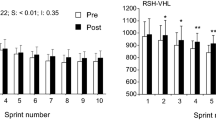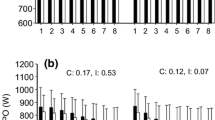Abstract
Previous studies have indicated that aerobic pathways contribute to 13–27% of the energy consumed during short-term (10–20 s) sprinting exercise. Accordingly, the present investigation was designed to test the hypothesis that prior breathing of oxygen-enriched air (FinO2 = 60%) would enhance power output and reduce fatigue during subsequent sprint cycling. Ten well-trained male cyclists (mean ± SD age, 25 ± 3 years; height, 186.1 ± 6.9 cm; body mass, 79.1 ± 8.2 kg; maximal oxygen uptake [VO2max]: 63.2 ± 5.2 ml kg−1 min−1) took 25 breaths of either hyperoxic (HO) or normoxic (NO) air before performing 15 s of cycling at maximal exertion. During this performance, the maximal and mean power outputs were recorded. The concentration of lactate, pH, partial pressure of and saturation by oxygen, [H+] and base excess in arterial blood were assessed before and after the sprint. The maximal (1,053 ± 141 for HO vs. 1,052 ± 165 W for NO; P = 0.77) and mean power outputs (873 ± 123 vs. 876 ± 147 W; P = 0.68) did not differ between the two conditions. The partial pressure of oxygen was approximately 2.3-fold higher after inhaling HO in comparison to NO, while lactate concentration, pH, [H+] and base excess (best P = 0.32) after sprinting were not influenced by exposure to HO. These findings demonstrate that the peak and mean power outputs of athletes performing short-term intense exercise cannot be improved by pre-exposure to oxygen-enriched air.





Similar content being viewed by others
References
Adams RP, Welch HG (1980) Oxygen uptake, acid-base status, and performance with varied inspired oxygen fractions. J Appl Physiol 49:863–868
Bogdanis GC, Nevill ME, Boobis LH, Lakomy HK (1996) Contribution of phosphocreatine and aerobic metabolism to energy supply during repeated sprint exercise. J Appl Physiol 80:876–884
Bogdanis GC, Nevill ME, Lakomy HK, Boobis LH (1998) Power output and muscle metabolism during and following recovery from 10 and 20 s of maximal sprint exercise in humans. Acta Physiol Scand 163:261–272
Chasiotis D (1983) The regulation of glycogen phosphorylase and glycogen breakdown in human skeletal muscle. Acta Physiol Scand Suppl 518:1–68
Cooke R, Pate E (1985) The effects of ADP and phosphate on the contraction of muscle fibers. Biophys J 48:789–798
Gaitanos GC, Williams C, Boobis LH, Brooks S (1993) Human muscle metabolism during intermittent maximal exercise. J Appl Physiol 75:712–719
Graham TE, Pedersen PK, Saltin B (1987) Muscle and blood ammonia and lactate responses to prolonged exercise with hyperoxia. J Appl Physiol 63:1457–1462
Hirvonen J, Rehunen S, Rusko H, Harkonen M (1987) Breakdown of high-energy phosphate compounds and lactate accumulation during short supramaximal exercise. Eur J Appl Physiol Occup Physiol 56:253–259
Jacobs I, Tesch PA, Bar-Or O, Karlsson J, Dotan R (1983) Lactate in human skeletal muscle after 10 and 30 s of supramaximal exercise. J Appl Physiol 55:365–367
Jacobs I, Esbjornsson M, Sylven C, Holm I, Jansson E (1987) Sprint training effects on muscle myoglobin, enzymes, fiber types, and blood lactate. Med Sci Sports Exerc 19:368–374
Jansson E, Esbjornsson M, Holm I, Jacobs I (1990) Increase in the proportion of fast-twitch muscle fibres by sprint training in males. Acta Physiol Scand 140:359–363
Kawada S, Fukaya K, Ohtani M, Kobayashi K, Fukusaki C (2008) Effects of pre-exposure to hyperbaric hyperoxia on high-intensity exercise performance. J Strength Cond Res 22:66–74
Knight DR, Schaffartzik W, Poole DC, Hogan MC, Bebout DE, Wagner PD (1993) Effects of hyperoxia on maximal leg O2 supply and utilization in men. J Appl Physiol 75:2586–2594
Linossier MT, Dormois D, Arsac L, Denis C, Gay JP, Geyssant A, Lacour JR (2000) Effect of hyperoxia on aerobic and anaerobic performances and muscle metabolism during maximal cycling exercise. Acta Physiol Scand 168:403–411
Macdonald M, Pedersen PK, Hughson RL (1997) Acceleration of VO2 kinetics in heavy submaximal exercise by hyperoxia and prior high-intensity exercise. J Appl Physiol 83:1318–1325
McCartney N, Spriet LL, Heigenhauser GJ, Kowalchuk JM, Sutton JR, Jones NL (1986) Muscle power and metabolism in maximal intermittent exercise. J Appl Physiol 60:1164–1169
Peltonen JE, Rantamaki J, Niittymaki SP, Sweins K, Viitasalo JT, Rusko HK (1995) Effects of oxygen fraction in inspired air on rowing performance. Med Sci Sports Exerc 27:573–579
Peltonen JE, Rusko HK, Rantamaki J, Sweins K, Niittymaki S, Viitasalo JT (1997) Effects of oxygen fraction in inspired air on force production and electromyogram activity during ergometer rowing. Eur J Appl Physiol Occup Physiol 76:495–503
Powers SK, Martin D, Dodd S (1993) Exercise-induced hypoxaemia in elite endurance athletes. Incidence, causes and impact on VO2max. Sports Med 16:14–22
Prieur F, Benoit H, Busso T, Castells J, Geyssant A, Denis C (2002) Effects of moderate hyperoxia on oxygen consumption during submaximal and maximal exercise. Eur J Appl Physiol 88:235–242
Reich T, Tuckman J, Naftchi NE, Jacobson JH (1970) Effect of normo- and hyperbaric oxygenation on resting and postexercise calf blood flow. J Appl Physiol 28:275–278
Richardson RS, Grassi B, Gavin TP, Haseler LJ, Tagore K, Roca J, Wagner PD (1999a) Evidence of O2 supply-dependent VO2max in the exercise-trained human quadriceps. J Appl Physiol 86:1048–1053
Richardson RS, Leigh JS, Wagner PD, Noyszewski EA (1999b) Cellular pO2 as a determinant of maximal mitochondrial O(2) consumption in trained human skeletal muscle. J Appl Physiol 87:325–331
Rousseau A, Bak Z, Janerot-Sjoberg B, Sjoberg F (2005) Acute hyperoxaemia-induced effects on regional blood flow, oxygen consumption and central circulation in man. Acta Physiol Scand 183:231–240
Spriet LL, Soderlund K, Bergstrom M, Hultman E (1987) Skeletal muscle glycogenolysis, glycolysis, and pH during electrical stimulation in men. J Appl Physiol 62:616–621
Stellingwerff T, Glazier L, Watt MJ, LeBlanc PJ, Heigenhauser GJ, Spriet LL (2005) Effects of hyperoxia on skeletal muscle carbohydrate metabolism during transient and steady-state exercise. J Appl Physiol 98:250–256
Tucker R, Kayser B, Rae E, Raunch L, Bosch A, Noakes T (2007) Hyperoxia improves 20 km cycling time trial performance by increasing muscle activation levels while perceived exertion stays the same. Eur J Appl Physiol 101:771–781
Webster AL, Syrotuik DG, Bell GJ, Jones RL, Bhambhani Y, Young M (1998) Exercise after acute hyperbaric oxygenation: is there an ergogenic effect? Undersea Hyperb Med 25:153–159
Wilber RL, Holm PL, Morris DM, Dallam GM, Callan SD (2003) Effect of F(I)O(2) on physiological responses and cycling performance at moderate altitude. Med Sci Sports Exerc 35:1153–1159
Wilkerson DP, Berger NJ, Jones AM (2006) Influence of hyperoxia on pulmonary O2 uptake kinetics following the onset of exercise in humans. Respir Physiol Neurobiol 153:92–106
Wilson GD, Welch HG (1975) Effects of hyperoxic gas mixtures on exercise tolerance in man. Med Sci Sports 7:48–52
Wilson BA, Welch HG, Liles JN (1975) Effects of hyperoxic gas mixtures on energy metabolism during prolonged work. J Appl Physiol 39:267–271
Author information
Authors and Affiliations
Corresponding author
Additional information
Communicated by Toshio Moritani.
Rights and permissions
About this article
Cite this article
Sperlich, B., Schiffer, T., Achtzehn, S. et al. Pre-exposure to hyperoxic air does not enhance power output during subsequent sprint cycling. Eur J Appl Physiol 110, 301–305 (2010). https://doi.org/10.1007/s00421-010-1507-6
Accepted:
Published:
Issue Date:
DOI: https://doi.org/10.1007/s00421-010-1507-6




